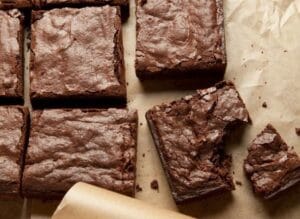If you’ve ever asked yourself, “Why are my brownies not chewy?”, you’re not alone. Achieving that perfect chewy texture can be tricky, even for experienced bakers. From ingredient choices to baking techniques, many factors can affect the outcome. This comprehensive guide will help you troubleshoot and fix the common issues that prevent your brownies from reaching that ideal chewiness.
1. Understanding What Makes Brownies Chewy
Chewy brownies strike a delicate balance between fudgy and cakey textures. The chewiness depends on the right mix of ingredients and proper baking techniques.
Key Factors for Chewiness:
- Fat-to-Flour Ratio: Higher fat content (butter or oil) increases moisture, making brownies chewier.
- Sugar Type: Granulated sugar crystallizes during baking, contributing to a chewier texture.
- Egg Content: Eggs add structure and help bind ingredients for a denser texture.
When wondering “Why are my brownies not chewy?”, start by evaluating these critical elements in your recipe.
2. Common Reasons Your Brownies Aren’t Chewy
If your brownies are turning out too cakey or dry, there could be several reasons. Identifying the root cause will help you make the necessary adjustments.
Possible Causes:
- Too Much Flour: Excess flour makes brownies dry and cakey.
- Insufficient Fat: Low butter or oil content reduces moisture.
- Overmixing: Overmixing incorporates too much air, leading to a lighter, cake-like texture.
- Overbaking: Baking brownies for too long dries them out, eliminating chewiness.
By addressing these issues, you can resolve the problem of “Why are my brownies not chewy?” effectively.
3. How to Fix Dry or Cakey Brownies
To improve your brownies, you can make specific changes to your ingredients and baking process.
Fixes for Chewier Brownies:
- Add More Fat: Use melted butter or oil to boost moisture levels.
- Adjust Sugar: Incorporate more granulated sugar for better crystallization.
- Reduce Flour: Slightly decrease the amount of flour for a softer texture.
- Mix Gently: Avoid overmixing to maintain density.
These simple fixes will help you achieve perfectly chewy brownies.
4. Ingredients That Affect Brownie Texture
The specific ingredients in your recipe play a significant role in determining the texture of your brownies.
Important Ingredients:
- Butter or Oil: Provides the fat needed for moisture and chewiness.
- Sugar: Granulated sugar contributes to chewiness, while brown sugar adds moisture.
- Cocoa Powder vs. Melted Chocolate: Cocoa powder creates a denser texture, while melted chocolate can add fudginess.
Adjusting these ingredients is key to resolving the issue of “Why are my brownies not chewy?”.
5. The Role of Baking Techniques
Even if you have the right ingredients, improper baking techniques can prevent your brownies from being chewy.
Technique Tips:
- Don’t Overbake: Remove brownies from the oven when the center is slightly undercooked; they’ll set as they cool.
- Use the Right Pan: A light-colored metal pan ensures even baking.
- Cool Properly: Allow brownies to cool completely before cutting to retain their chewiness.
Mastering these techniques will improve the texture of your brownies significantly.
6. How to Make Brownies Chewier: A Step-by-Step Guide
Follow these steps to ensure your brownies come out perfectly chewy every time.
Chewy Brownie Recipe Adjustments:
- Increase Fat: Use melted butter or a combination of butter and oil.
- Incorporate Granulated Sugar: This helps create a denser texture.
- Reduce Baking Time: Bake at a slightly lower temperature to prevent overcooking.
- Cool Before Cutting: This step allows the brownies to set properly.
By tweaking your recipe and technique, you’ll never have to ask “Why are my brownies not chewy?” again.
7. Common Mistakes to Avoid
Avoiding common mistakes is just as important as following the right steps. Small errors can significantly impact the texture of your brownies.
Mistakes That Affect Chewiness:
- Using Too Little Fat: Leads to dry, crumbly brownies.
- Overmixing Batter: Incorporates air, making brownies cakey instead of chewy.
- Skipping Parchment Paper: Makes removal harder, potentially disrupting texture.
Steering clear of these mistakes will ensure consistently chewy brownies.
8. Chewy Brownie Variations to Try
Once you’ve mastered the art of making chewy brownies, experiment with creative variations.
Chewy Brownie Ideas:
- Nutty Brownies: Add chopped walnuts or pecans for texture contrast.
- Peanut Butter Swirl: Create a creamy swirl of peanut butter in the batter.
- Espresso Brownies: Add espresso powder to enhance the chocolate flavor.
These variations keep your brownies exciting while maintaining their chewiness.
9. Frequently Asked Questions About Chewy Brownies
Why are my brownies too cakey?
Too much flour, overmixing, or excess leavening agents can make brownies cakey. Adjust fat and sugar ratios for a chewier texture.
Can I use oil instead of butter for chewier brownies?
Yes! Oil can make brownies even more moist and chewy, but it may alter the flavor slightly.
How do I store chewy brownies?
Store in an airtight container at room temperature for up to 3 days. Refrigerate for longer storage, but allow brownies to come to room temperature before serving.
10. Why Chewy Brownies Are Worth the Effort
Chewy brownies are the perfect dessert, combining the richness of chocolate with a satisfying texture. By understanding the factors that influence texture—like fat content, sugar ratios, and baking techniques—you can consistently create brownies that are moist, dense, and irresistible.
Why Are My Brownies Not Chewy?
Achieving the perfect brownies can sometimes feel like an elusive goal. If you’ve ever asked yourself, “Why are my brownies not chewy?”, this guide is here to help. From ingredients to baking techniques, we’ll explore what might be going wrong and how to fix it.
To dive deeper into brownie preparation techniques, check out Brownie Icing Recipe for additional insights.
1. Understanding Chewy Brownies
Chewiness is a texture that comes from balancing moisture, fat, and gluten development. Without this balance, brownies can turn out cakey or dry instead.
Characteristics of Chewy Brownies:
- Moist Texture: Requires adequate fat and sugar content.
- Dense Structure: Fewer leavening agents help maintain chewiness.
- Glossy Top: A hallmark of well-balanced ingredients.
Learn how to achieve this balance with tips from Whipped Cream on Brownies, where toppings and texture interplay are explored.
2. Common Reasons Brownies Are Not Chewy
There are many factors that can affect chewiness, and it’s crucial to identify where the issue lies.
Key Culprits:
- Too Much Flour: Excess flour makes brownies dense but not chewy.
- Not Enough Fat: Chewy brownies rely on fat, such as butter or oil.
- Overmixing: Developing too much gluten creates a tough texture.
For storage tips that can impact texture over time, visit Brownie Cooling and Storage Tips.
3. Ingredient Adjustments for Chewy Brownies
Tweaking ingredients can make a significant difference in texture.
Adjustments to Try:
- Brown Sugar: Its molasses content retains moisture.
- Extra Yolk: Adding an egg yolk enhances richness.
- Melted Chocolate: Intensifies flavor and adds moisture.
For professional insights on improving Ghirardelli brownies, explore Improve Ghirardelli Brownie Mix.
4. Baking Techniques to Improve Chewiness
Perfect baking techniques are essential for achieving the desired texture.
Tips for Baking:
- Lower Oven Temperature: Bake longer at a lower temperature to avoid drying.
- Test for Doneness Early: A toothpick with moist crumbs is a good indicator.
- Cool in Pan: Retains moisture and sets the chewy structure.
For expert advice on the science behind baking, check out this resource from King Arthur Baking for tips on flour and dough behavior.
5. How Mixing Affects Chewy Brownies
Mixing is where many brownie recipes fail. Overmixing introduces too much air, leading to a cake-like texture.
Mixing Tips:
- Use a spatula for folding dry ingredients into wet.
- Avoid using a whisk or mixer for too long.
- Combine ingredients just until incorporated.
Learn the art of creating dense batters with guidance from Serious Eats.
6. Enhancing Chewiness with Add-Ins
Add-ins can improve texture while elevating flavor.
Top Add-In Ideas:
- Chopped Nuts: Walnuts or pecans for crunch.
- Chocolate Chips: Melting pockets enhance gooeyness.
- Caramel Swirls: Adds moisture and a hint of sweetness.
Visit Decorate Brownies for inspiration on toppings and visual appeal.
7. Storing Brownies to Maintain Chewiness
How you store brownies affects their texture over time. Improper storage can lead to dryness.
Storage Tips:
- Airtight Containers: Prevent moisture loss.
- Avoid Refrigeration: Unless using perishable ingredients like cream cheese.
- Freezing: Wrap individually and thaw for a chewy texture.
Get more storage tips from Taste of Home for keeping baked goods fresh.
8. Why Chewy Brownies Are Worth It
Chewy brownies offer the perfect middle ground between cakey and fudgy textures. Their dense, moist structure makes them versatile and universally appealing.
Why They’re Popular:
- Perfect for pairings with ice cream or whipped cream.
- Ideal for layered desserts.
- Loved by all ages and for all occasions.
Conclusion
The question “Why are my brownies not chewy?” often comes down to small adjustments in ingredients, mixing, and baking techniques. By following the tips and insights provided, you’ll be able to create perfect brownies that impress every time. Explore internal resources like Whipped Cream on Brownies or Improve Ghirardelli Brownie Mix for more brownie baking tips, and visit King Arthur Baking for deeper baking science.
Let your next batch be the chewiest yet!


2 thoughts on “Why Are My Brownies Not Chewy? Tips to Fix Texture Issues”